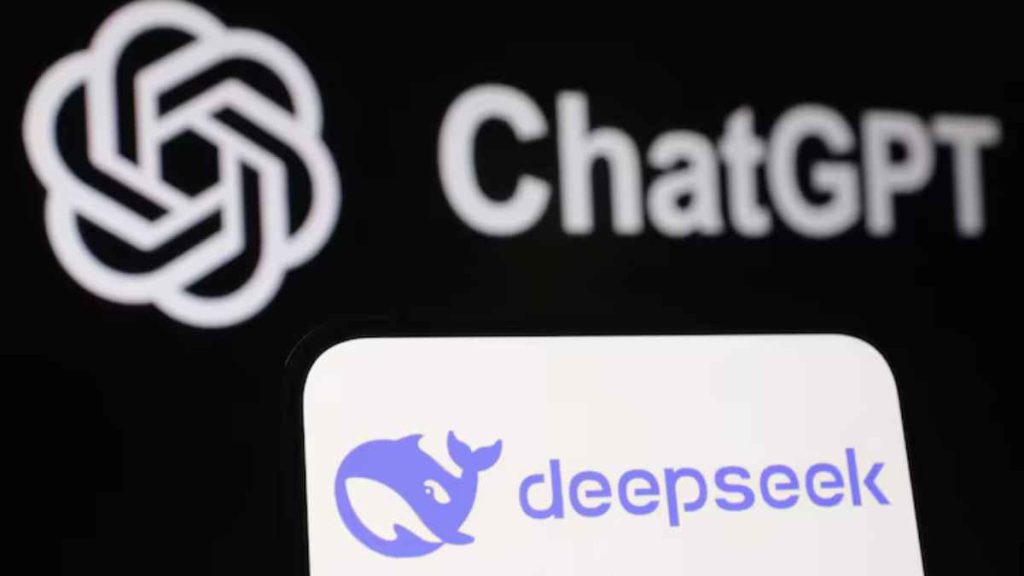Last week, a staggering $1 trillion was wiped off global stock markets, triggered by the launch of an AI model from the Chinese start-up DeepSeek. The R1 model has made waves by challenging the assumption that the US dominates AI development. It can solve complex scientific problems and perform at a level on par with leading US AI models, yet it was developed at a fraction of the cost.
DeepSeek’s breakthrough has caused concern in Silicon Valley. R1 quickly became the most-downloaded free app on the US iOS App Store, displacing ChatGPT. The success raises a key question: Has China caught up in AI development just as the industry nears artificial general intelligence (AGI), where machines reach human-like intelligence?
DeepSeek, founded by billionaire Liang Wenfeng in 2023, has taken a Silicon Valley-inspired approach. It focuses purely on research without seeking external funding, allowing it to remain free from the pressures that often accompany state-backed companies. Liang’s approach reflects a boldness he believes is essential to innovation. “Silicon Valley is innovative because they dare to do things,” he said, noting that many in China lacked confidence in pioneering AI technology.
The company’s breakthrough came from its ability to train R1 using far fewer resources than US rivals. DeepSeek claims the final training for R1 cost only $5.6 million, compared to hundreds of millions spent by US firms like OpenAI. This achievement was, in part, made possible by China’s inability to access the most advanced US chips due to export restrictions. As a result, DeepSeek had to find innovative ways to make the most of less powerful technology.
Despite its success, the company has faced some controversy. OpenAI has claimed that DeepSeek used its own models in training R1, which would violate OpenAI’s terms of use, though such practices are believed to be common in the industry.
DeepSeek’s rise also challenges the narrative that AI requires massive amounts of capital and infrastructure to succeed. Some in Silicon Valley downplay its significance, suggesting that its innovations will be quickly replicated. However, others, like Sam Altman of OpenAI, acknowledged that R1 is “impressive” but noted that the rapid pace of AI development makes it difficult to determine whether DeepSeek will have lasting impact.
The real significance of DeepSeek’s rise lies in the way it is altering the balance of the global AI race. Its models are available at a significantly lower cost than those of US competitors, which has the potential to disrupt the AI market. For instance, while Meta charges $2.80 per million tokens, DeepSeek charges just 1.4 cents, making its technology much more accessible to developers worldwide.
In the end, DeepSeek’s success highlights the growing strength of China’s AI capabilities. While some argue that China is still behind in pushing AI frontiers, others believe that DeepSeek’s achievements are a sign that China is now a serious contender in the global AI race. This shift could have wide-ranging geopolitical consequences, with implications not just for technology but for military and global power dynamics as well.



86 Comments
Partner with us and earn recurring commissions—join the affiliate program! https://shorturl.fm/2J8aR
Drive sales, earn commissions—apply now! https://shorturl.fm/SkOXX
Start profiting from your network—sign up today! https://shorturl.fm/gvR7d
Share our products, earn up to 40% per sale—apply today! https://shorturl.fm/rAjUH
Refer friends, earn cash—sign up now! https://shorturl.fm/k7Pvz
Share our products, reap the rewards—apply to our affiliate program! https://shorturl.fm/qQXy2
Join our affiliate program and watch your earnings skyrocket—sign up now! https://shorturl.fm/0rYNn
Invite your network, boost your income—sign up for our affiliate program now! https://shorturl.fm/sln25
Your network, your earnings—apply to our affiliate program now! https://shorturl.fm/ft3z2
Sign up for our affiliate program and watch your earnings grow! https://shorturl.fm/g9bVT
Sign up and turn your connections into cash—join our affiliate program! https://shorturl.fm/0tqxI
Drive sales, collect commissions—join our affiliate team! https://shorturl.fm/xUI1k
Join our affiliate community and earn more—register now! https://shorturl.fm/5Xkc3
https://shorturl.fm/Z60tR
https://shorturl.fm/vrr9q
https://shorturl.fm/YDcO7
https://shorturl.fm/jHJNV
https://shorturl.fm/JGGoi
https://shorturl.fm/kjatN
https://shorturl.fm/ioGFO
https://shorturl.fm/R4maX
https://shorturl.fm/39Xll
https://shorturl.fm/Et9lc
https://shorturl.fm/aNMET
https://shorturl.fm/OrpIm
https://shorturl.fm/uaXOT
https://shorturl.fm/iWRWQ
https://shorturl.fm/ln80x
https://shorturl.fm/E6dz8
https://shorturl.fm/AwDMY
https://shorturl.fm/I1Q2N
https://shorturl.fm/9IZBw
https://shorturl.fm/lFAAr
https://shorturl.fm/V8BMx
https://shorturl.fm/70fmQ
https://shorturl.fm/VFtP2
https://shorturl.fm/J1j43
https://shorturl.fm/ZM8p8
https://shorturl.fm/hV8kt
https://shorturl.fm/qzevq
https://shorturl.fm/bxbCN
https://shorturl.fm/1XZaw
https://shorturl.fm/8awca
https://shorturl.fm/jI4o6
https://shorturl.fm/kXPub
https://shorturl.fm/cNWe8
https://shorturl.fm/ul2dZ
https://shorturl.fm/H1vbb
https://shorturl.fm/O98lo
https://shorturl.fm/4ERPd
https://shorturl.fm/WQP7C
https://shorturl.fm/MoCl7
https://shorturl.fm/dqHpi
https://shorturl.fm/G81jv
https://shorturl.fm/NxRdB
https://shorturl.fm/3JWrH
wa4l1f
https://shorturl.fm/SXmHR
https://shorturl.fm/NhBYi
https://shorturl.fm/xVHeN
https://shorturl.fm/xd4Rl
https://shorturl.fm/RrD3X
https://shorturl.fm/qnjWx
https://shorturl.fm/wVheC
https://shorturl.fm/BQS2O
https://shorturl.fm/dwiTx
wnp4a9
https://shorturl.fm/Tty6x
https://shorturl.fm/tGgMj
https://shorturl.fm/cwbOz
https://shorturl.fm/2ClfZ
https://shorturl.fm/zzeah
https://shorturl.fm/ZyKjx
https://shorturl.fm/yFxPM
https://shorturl.fm/bcmBz
https://shorturl.fm/4av9G
https://shorturl.fm/Yfqn7
pfye7e
wroq33
03k1z6
ssbn7q
zo3fgu
This web site is really a walk-through for all of the info you wanted about this and didn’t know who to ask. Glimpse here, and you’ll definitely discover it.
I am not really wonderful with English but I find this rattling easy to understand.
It’s a shame you don’t have a donate button! I’d certainly donate to this superb blog! I guess for now i’ll settle for book-marking and adding your RSS feed to my Google account. I look forward to brand new updates and will share this blog with my Facebook group. Chat soon!
Very interesting info !Perfect just what I was searching for! “…obstacles do not exist to be surrendered to, but only to be broken.” by Adolf Hitler.